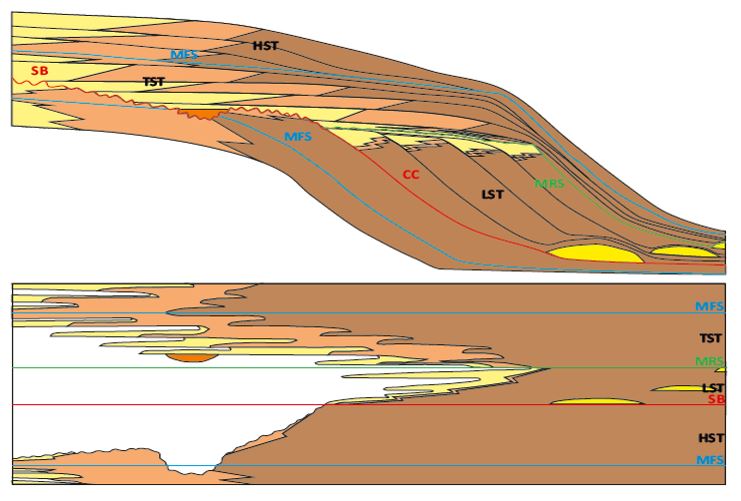This is an old revision of the document!
Table of Contents
Characterising Sequence Components Using Fossils
We need to establish characteristic “paleontological signatures” or “fingerprints” for surfaces and components of a sequence. In order to do that we need to know how the fossils – as living organisms – respond to changes in sea level and, to an extent, sediment supply.
Sequence surfaces provide the broad features that separate individual sequences and sequence components and also the mechanism by which sequences are biostratigraphically calibrated and therefore correlated on a well-to-well and eventually regional basis.

Schematic diagram of a typical third-order depositional sequence and its main components. The upper image is scaled against rock thickness, the lower image is scaled to time.
The three main surfaces which occur within an individual sequence are:
- the sequence boundary (SB) or (distally) correlative conformity (CC)
- the maximum regressive surface (MRS) (sometimes called the “transgressive surface (TS)”)
- the maximum flooding surface (MFS).
The SB is a negative surface in that, its proximal expression is as an unconformity, it represents a period of missing time expressed as erosion or at least non-deposition. In distal settings deposition may be continuous (though at a very low rate) and therefore an unconformity (in the strict sense) may not be present. This surface is termed a Correlative Conformity (CC).
The same may also be said in some respects of the MRS.
The MFS is a positive surface expressed within an actual rock unit representing (more-or-less) continuous deposition during the maximum landward extent of marine conditions, although at a far greater extent that the CC, usually extending from very proximal areas and well into the basin.
The importance of the surfaces is that, because they are eustatically controlled, they are laterally extensive. Furthermore if they can be biostratigraphically calibrated with consistent marker species, they can be correlated at basin, region and even global scales.
The rock units between the surfaces are called Systems Tracts. They effectively build the rock record. The principle systems tracts are:
- the lowstand systems tract (LST) comprising the lowstand wedge (LSW) and fan (LSF)
- the transgressive systems tract (TST)
- the highstand systems tract (HST) including the shelf-margin wedge (SMW)
(The LSF and SMW are often not developed)
It is important to note that, at a single location - such as the vertical penetration by a borehole of a subsurface sequence - not all sequence components will be encountered. For example, when encountering the distal part of a sequence it is unlikely that any HST sediments will be observed.
